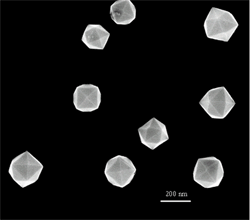Nanostructured materials empower energy advances
Recent developments at the Center for Nanostructure Characterization and Fabrication at the Georgia Institute of Technology in Georgia aim to change the face of energy generation at both a micro and macro level. Both technology advancesone for hydrogen converters and the other for energy harvestinginvolve use of nanofabricated materials whose structure is critical to improved energy efficiency.
Last month, Zhong Lin Wang, a Regents Professor in the School of Materials Science and Engineering, and other research team members announced the creation of tetrahexahedral (24-sided) nanocrystals of platinum for the first time (see Fig. 1 ). When used in catalytic converters producing hydrogen for fuel cells, the crystal can produce up to four times the catalytic activity per unit area as the spherical crystals currently being used. The nanocrystals are produced from platinum nanospheres on a carbon substrate using an electrochemical process in which particle size is controlled by applying a 10 to 20-Hz square wave over a period of 10 to 60 min.

Fig. 1. A low magnification SEM image shows several 24-facet platinum nanocrystals.
Though the process must still be fine-tuned, the structures have thus far remained stable at temperatures to 800C, which would allow them to be recycled and re-used in catalytic reactions according t o Wang. Researchers are able to control the size such that only 4.5% the nanocrystals produced are larger or smaller than the target sizethe smallest units produced to date are 20 nm in diameterbut want to find a way to make the nanocrystals even smaller while preserving the shape. Wang notes, “If we can reduce the size through better control of processing conditions, we will have a catalytic system that would allow production of hydrogen with greater efficiency.”
The previous month, Wang’s group demonstrated a prototype nanometer-scale generator that produces continuous dc power by harvesting mechanical energy from such environmental sources as ultrasonic waves or mechanical vibration, or even blood flow. Based on arrays of vertically-aligned zinc oxide nanowires that move inside a novel “zig-zag” plate electrode, the nanogenerators could power nanoscale devices without batteries or other external power sources. The nanogenerators take advantage of the unique coupled piezoelectric and semiconducting properties of zinc oxide nanostructures, which produce small electrical charges when flexed (see Fig. 2 ). Fabrication begins with growing an array of nanowires approximately 0.5 μm apart on gallium arsenide, sapphire, or a flexible polymer substrate. A layer of zinc oxide is grown on top of substrate to collect the current. The researchers then fabricate silicon “zig-zag” electrodes, which contain thousands of nanometer-scale tips made conductive by a platinum coating, which is placed on top of the array but leaves just enough space so that nanowires are free to flex within the gap.

Fig.2. The prototype direct-current nanogenerator (left) uses an array of flexible zinc-oxide nanowires (right) that generate current when vibrated.
When moved by mechanical energy, the nanowires periodically contact the tips, transferring their electrical charges to produce nA-range current. Researchers expect that with optimizations the device could produce as much as 4 W/cm3.
For more information on both developments, call Zhong Lin Wang at 404-894-8008 or e-mail
.
Richard Comerford
Advertisement
Learn more about Georgia Institute of Technolog





